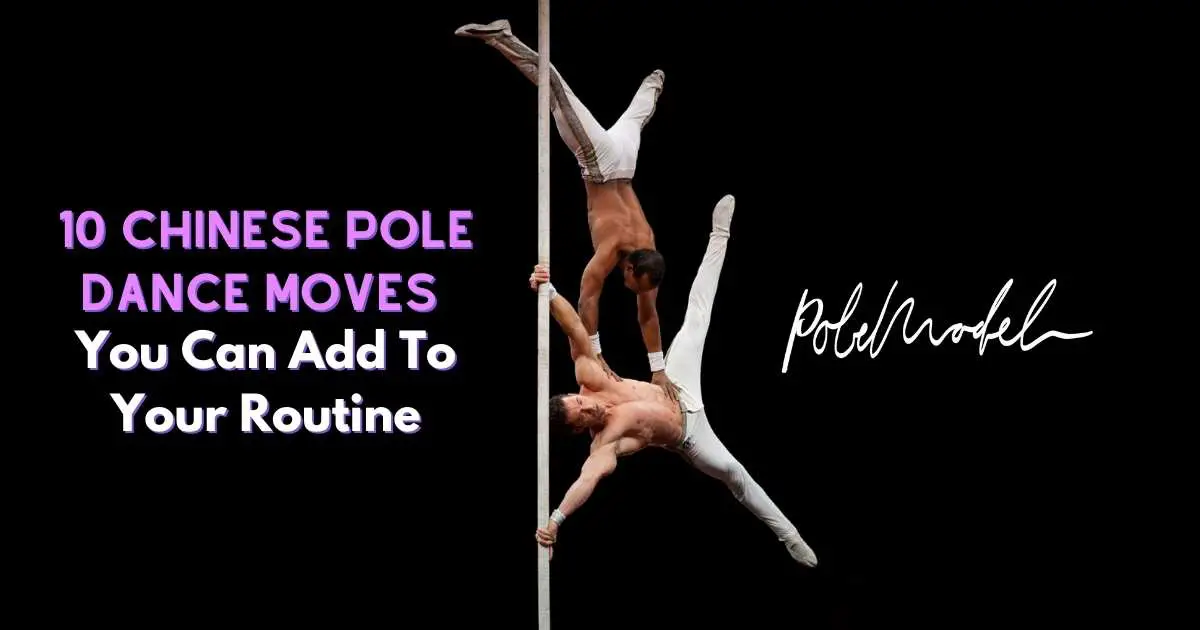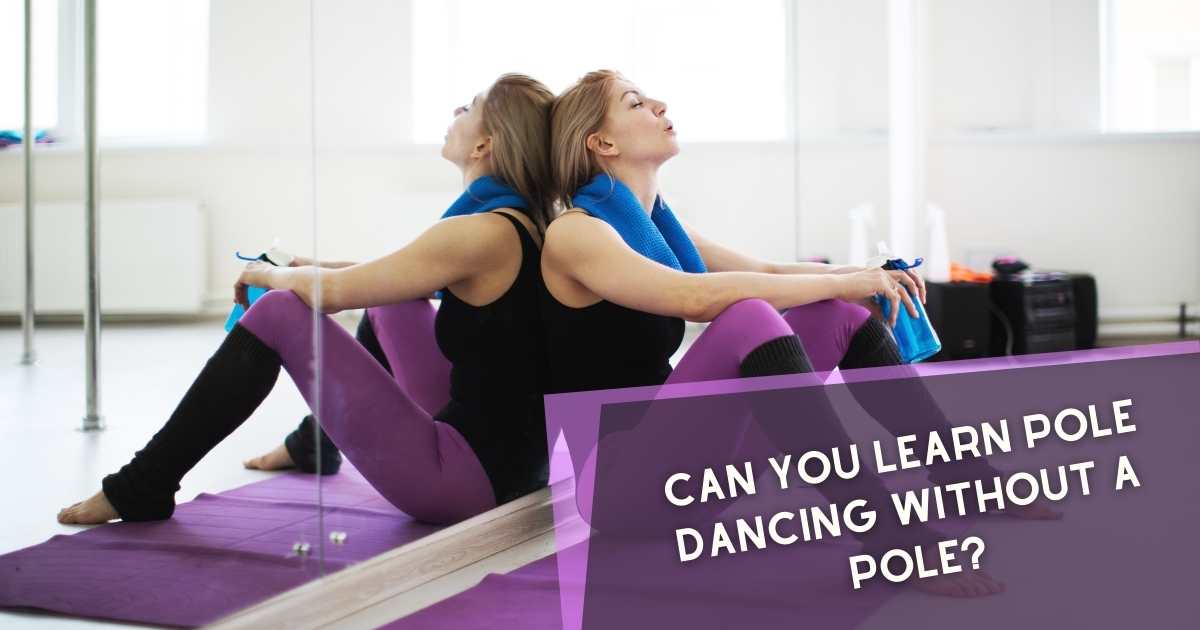In this article, I cover all of the basics of Chinese pole dance (just Chines pole, really) and how you can incorporate some techniques into your own style of pole. You might find this education and insightful, the similarities, differences, and overall strategy a little bit surprising.
Learning Chinese Pole
I first saw Chinese Pole Dance on a stage in the Cirque du Soleil production, Saltimbanco, and it completely took my breath away.
I was astonished by the acrobats’ effortless poise as they maneuvered nimbly up and down poles, performing death-defying stunts across a series of dizzying heights.
I’ve wanted to learn to scale these giant circus poles ever since!
Chinese pole dance is a distinct style of pole dancing from the one you’re probably used to, although there are several apparent similarities. A lot of the postures and grips appear identical, and I was eager to discover how Chinese pole might broaden my pole dance arsenal by introducing new techniques.
Chinese Pole Dance: Differences & Similarities
Pole Material
The biggest difference with Chinese pole is that while it still uses a metal pole, the pole is typically coated in rubber.
This gives the performer a considerable amount of extra grip and, as you can imagine, makes some poses a lot easier! However, this rubber pole pretty much rules out moves like spins.
Pole Size
Due to its circus origins, the poles are much higher than ones we’re used to, often reaching 9 or 10m (27-30′) high.
The pole is wider, too, typically reaching 7-10cm (3-4″) in diameter. This makes a big difference when grasping the pole and also gives larger-handed or male acrobats a significant edge!
Similar to a stage pole, Chinese poles are free-standing. They’re held in place with a circus rigging, which secures the bottom of the pole to the floor directly and the top of the pole to the floor via a pair of long straps.
This means that the pole has a slight ‘give’ to it, and the extra swaying or looseness can be quite disconcerting when you first mount it!
Painful Poling
As you know, after an intense session of pole dancing, your skin is sure to be tingling with excitement (well, that is another way to describe those delightful pole kisses we get!).
You will be happy to know; you still get these with Chinese pole. In fact, Chinese pole dance can be considerably less forgiving; any exposed skin is inclined to get burnt pretty quickly as friction heats it up when sliding down the pole… Ouch!
But it isn’t all bad; the rubber coating means you can get some extra grip through clothes, though complete protection is not always possible. (In fact, according to Wikipedia, Chinese pole artists use the burn marks left on their shoulders as a way to recognize each other. Sort of like a secret society handshake!)
One For The Men
Similar to mallakhamb, Chinese pole is normally performed by male acrobats. The reasons for this are likely to be historic or tradition in nature (i.e. men do it because men do it). Additionally, a man’s greater natural strength – and particularly upper body strength – is an advantage for many holds and poses.
Perhaps the most famous Chinese pole pose (and yes, it’s a strength move and staple in the world of calisthenics and bar work) is the flag.
Check out this video of Dominic Lacasse, who holds a world record for the flag here. He manages to hold this pose for an insane 43.5s.
Chinese Pole: Holds & Techniques
My first lesson with my instructor was a bit of a struggle, but it was also exciting. I learned ten poses, mostly transitions and rest postures, in addition to the usual Chinese climb. The majority of the moves work well on a dance pole, although some are more difficult owing to lower grip levels.
Chinese pole Climb
The Chinese pole Climb places both feet flat on the pole. You tend to use more the ball of the foot pushing in. It’s important to keep the hips towards the pole and bent arms. The second you find yourself sinking back with straight arms it becomes very hard. I found this difficult at first as it was a very foreign way to climb the pole. (Plus I had completely the wrong shoes on!)
This climb is harder on a dance pole, but it’s great fun to do in bare feet or wearing a grippy pair of trainers. It’s an energetic and unusual way to start a routine, and can look particularly striking if you’re performing on a tall pole.
Gazelle Change
Invert into the Gemini, but keep your free leg straight and dropping over your back, rather than sinking into the classic Gemini position.
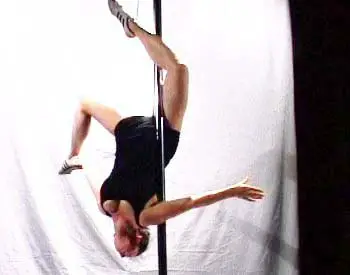
Then swing your free leg towards you, squeeze between your thighs, swing your torso around the pole, gripping the pole in your armpit, and finally change your leg to the Reverse Gemini. Then you can repeat the move again in the other direction.
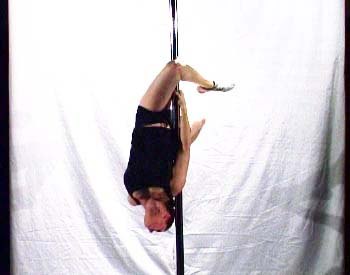
The Gazelle is harder on a dance pole because of the lack of rubber, but it’s still very doable. Step through the move slowly at first, and remember to grip with your thighs. I also recommend using your hands on the pole to change sides at first.
Make sure you start nice and high as the body does descend a little during this move, and be prepared to ignore the burn on your outside leg as you change position and ‘drop’ into the end pose – ouch!
If you’re precise enough, it’s a very dramatic way to do the Gemini over and over again in a routine, changing sides as you descend.
Hip Lock and Drop
The Hip Lock is a variation on the Sit.
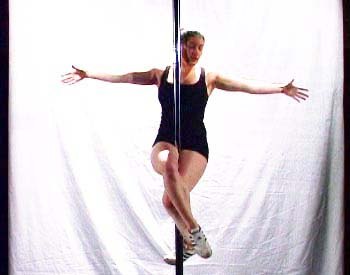
With the pole centered, twist the legs as though you’re going into the Barbed Wire, then lean forwards and round the pole to lock the pose.
The Hip Lock and Drop starts with a Hip Lock at the top of the pole. From there, slowly slide down by relaxing your body and allowing a little slip.
After I’d done this, my instructor got me to speed it up. I went to the top, took a deep breath and released, and tightened again as the ground came rushing up to meet me. It took my breath away!
Other Chinese Pole Positions
- Frog – A rest position. Bend both feet and knees outwards, placing the feet onto the pole below your bottom. Your hips should be open. Bring your dominant arm around the front of the pole to lock-in. You can also straighten your dominant leg out once locked—a very traditional circus move.
- Rest position 2 – Like the Icon, but place your less dominant foot onto the pole to create grip, rather than using the side of your leg.
- Leg Lock – Another variation on the Sit. Sit on the pole and get into the Ox (cross your non-dominant leg on the pole, put the back of your dominant leg’s knee around your foot, and hook your dominant foot under the pole to create the lock).
- Attitude – The Knees Variation with your lower foot on the pole to create the lock. It’s important to angle the foot towards the ground and keep your hips forward.
- Lay Back – Like the Fang, but grip with the thighs rather than the feet.
- Handstand – A Double Grip Straight Edge. Stand next to the pole, take the hand position, and kick up into it.
- Hip Lock Walk Down – Take the Hip Lock position, then straighten your left leg and walk your hands down the pole, squeezing with your legs until the straight leg hooks on the back of the pole with the foot. You can hold this position with no hands on the pole before setting up to do the Handstand.
I got a huge amount out of my first lesson, but it also made me realize just how much I still have to learn. And my goodness, I hurt the following day! I thought I was pole fit, but I now know just how hard I need to work at building up my core strength in particular. I felt like I had run a marathon!
Chinese Pole Dancing
The pole community has grown hugely in the past few years. Once upon a time, there were only about 60 or so known moves and spins. You only need to check sites like OpenDance Academy which lists hundreds of moves, for evidence of the explosion of creativity since pole first popped up as a desired hobby.
But there’s still huge unexplored potential, and a huge amount we can learn from Chinese pole in pole dancing. I hope to introduce it into my own teaching and routines soon and can’t wait for my next lesson!
Have you used any of these (or other) Chinese pole moves in your pole routines? Would you like to learn more? I’m really excited about the possibilities, and I’d love to know what you think too!
Some Cool Chinese Pole Videos To Check Out!
Cover image attribution: Ludovic Péron, Leosvel et Diosmani – 4, background by n/a, CC BY-SA 3.0

